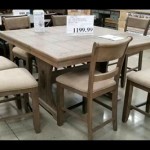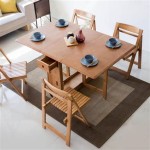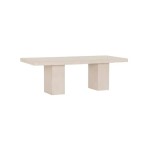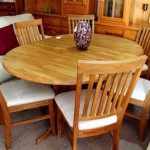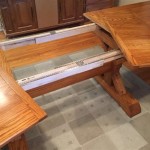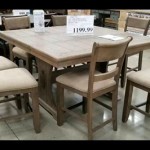Decoding the Dimensions: Understanding the Size of a 10-Person Dining Table
The dining table serves as a central gathering point within a home, facilitating meals, conversations, and shared experiences. Selecting the appropriate size dining table is crucial for ensuring both functionality and aesthetic harmony within the dining space. A 10-person dining table, specifically, presents a significant consideration, typically chosen for larger families or those who frequently entertain. Understanding the dimensions, shapes, and spatial requirements is paramount before committing to such a substantial piece of furniture. This article will delve into the typical sizes of 10-person dining tables, the factors influencing size selection, and provide guidance on optimizing space for comfortable seating and movement.
When contemplating a 10-person dining table, the most immediate question revolves around its physical dimensions. The standard dimensions vary depending on the table's shape, a key determinant of functionality and spatial efficiency. Rectangular tables, the most common choice for seating larger groups, generally range from 84 to 120 inches in length and 42 to 48 inches in width. An oval table, offering a similar seating capacity, will possess comparable dimensions, though it may appear more compact due to the curved edges. Round tables designed for 10 people typically require a diameter of at least 60 inches, but a diameter closer to 72 inches is generally recommended to provide adequate elbow room and prevent a crowded feel. Square tables can also accommodate 10 people, albeit less frequently, and necessitate dimensions of at least 60x60 inches, with larger sizes offering greater comfort.
These measurements are not arbitrary; they are derived from an understanding of human ergonomics and dining etiquette. A comfortable place setting typically requires a width of approximately 24 inches and a depth of 12 to 15 inches. This translates to a minimum of 24 inches per person along the perimeter of the table. Furthermore, sufficient space must be allocated for serving dishes in the center of the table or on adjacent serving surfaces. The depth of the table, generally ranging from 42 to 48 inches, provides ample room for these serving dishes without encroaching on individual dining spaces.
Beyond the dimensions of the table itself, the surrounding space plays a critical role in ensuring a comfortable and functional dining area. Adequate clearance around the table is essential for easy movement and prevents a cramped or claustrophobic environment. As a general rule, a minimum of 36 inches of clearance should be maintained between the edge of the table and any walls or other furniture. This allows individuals to comfortably pull out their chairs and move around the table without obstruction. Ideally, 42 to 48 inches of clearance is preferable, particularly in high-traffic areas or where there are frequently multiple people moving around the table simultaneously.
The height of the dining table is another important element, though it is generally more standardized than the length and width. Standard dining table height typically falls between 28 and 30 inches. This height is designed to be compatible with standard dining chair heights, which typically range from 16 to 20 inches from the seat to the floor. The difference between the table height and chair seat height allows for comfortable legroom and proper posture while seated. Deviations from these standard heights can lead to discomfort and potentially affect the overall dining experience.
Key Point 1: Shape Matters – Rectangular, Oval, Round, and Square Tables
The shape of a 10-person dining table significantly influences its spatial efficiency and seating dynamics. Rectangular tables are the most common and versatile choice, offering ample linear space for seating and facilitating easy conversation across the table. They are well-suited for rectangular dining rooms and can be effectively positioned against a wall when not fully occupied. However, rectangular tables can sometimes feel formal or impersonal, especially in larger spaces.
Oval tables, with their rounded ends, offer a softer aesthetic and can create a more intimate dining experience. The absence of sharp corners makes them a safer option for households with young children, and they tend to occupy less visual space than rectangular tables with similar dimensions. However, the curved ends can sometimes limit the number of people who can comfortably sit around the table, especially if the chairs are bulky.
Round tables foster a sense of equality and encourage conversation among all diners. The circular shape eliminates any sense of hierarchy and promotes eye contact, making it ideal for social gatherings and lively discussions. However, round tables require a larger amount of floor space compared to rectangular or oval tables, as they need to be centrally positioned in the room to allow for adequate circulation. Furthermore, reaching serving dishes in the center of a large round table can be challenging for some diners.
Square tables, while less common for seating 10 people, offer a unique and symmetrical aesthetic. They work well in square-shaped dining rooms and can create a sense of balance and formality. However, square tables require a considerable amount of space and can feel isolating if not properly proportioned to the size of the room. Seating placement can also be awkward, potentially leaving individuals feeling distant from one another.
Key Point 2: Material and Construction – Impacting Stability and Longevity
The choice of material and construction method profoundly impacts the stability, durability, and aesthetic appeal of a 10-person dining table. Solid wood tables are renowned for their strength, longevity, and timeless beauty. Hardwoods such as oak, maple, and walnut are particularly favored for their resistance to wear and tear. Solid wood tables are typically heavier and more expensive than tables made from other materials, but they offer superior stability and can be refinished multiple times, extending their lifespan considerably.
Veneer tables, constructed from a thin layer of wood adhered to a core material such as plywood or MDF (medium-density fiberboard), offer a more affordable alternative to solid wood. Veneer tables can replicate the appearance of solid wood at a lower cost, and the underlying core material can provide greater stability and resistance to warping. However, veneer tables are more susceptible to damage and cannot be refinished as easily as solid wood tables.
Metal tables, often featuring steel or aluminum frames, offer a contemporary and industrial aesthetic. Metal tables are known for their strength, durability, and resistance to scratches and stains. They are often paired with glass or wood tops, creating a visually striking contrast. Metal tables are generally lighter than solid wood tables, making them easier to move and reconfigure.
Other materials, such as glass, stone (marble, granite), and acrylic, can also be used for dining table tops. Glass tables offer a clean and modern look, but they can be prone to scratches and fingerprints. Stone tables are exceptionally durable and add a touch of luxury to the dining space, but they are also very heavy and expensive. Acrylic tables offer a lightweight and versatile option, but they may not be as durable as wood or metal.
The construction method also plays a vital role in the table's stability and longevity. Tables with solid wood frames and sturdy joinery are generally more durable than tables with flimsy frames or poorly constructed joints. Look for tables with mortise-and-tenon joints, dovetail joints, or metal-to-metal connections, as these are known for their strength and resistance to loosening over time.
Key Point 3: Optimizing Space – Clearance, Lighting, and Adjacent Furniture
Optimizing the space around a 10-person dining table is crucial for creating a comfortable and functional dining area. As previously mentioned, adequate clearance is essential for easy movement and prevents a cramped environment. A minimum of 36 inches of clearance between the edge of the table and any walls or other furniture is recommended, with 42 to 48 inches being preferable.
The placement of lighting fixtures can significantly impact the ambiance and functionality of the dining area. A centrally located chandelier or pendant light directly above the table provides ample illumination for dining and adds a touch of elegance. Dimmable lighting allows for adjusting the brightness to suit different occasions, from casual family meals to formal dinner parties. Additional lighting, such as wall sconces or table lamps, can be used to create a layered and inviting atmosphere.
The selection and placement of adjacent furniture also contribute to the overall functionality and aesthetic appeal of the dining space. A buffet or sideboard provides convenient storage for serving dishes, silverware, and linens, reducing clutter on the table during meals. A bar cart offers a dedicated space for preparing and serving drinks, streamlining the entertaining process. Consider the style and scale of these pieces to ensure they complement the dining table and create a cohesive look.
Rugs can be used to define the dining area and add warmth and texture to the space. Select a rug that is large enough to accommodate the dining table and chairs, with at least 24 inches of rug extending beyond the perimeter of the table. This ensures that the chairs remain fully on the rug, even when pulled out. Choose a rug material that is durable and easy to clean, as dining areas are prone to spills and stains.
Finally, consider the overall flow of traffic through the dining area. Ensure that there are clear pathways for people to move around the table without obstruction. Avoid placing furniture or decorative items that could impede movement or create a tripping hazard. A well-planned dining space should be both functional and aesthetically pleasing, creating a welcoming environment for shared meals and social gatherings.
In summary, carefully considering the dimensions, shape, material, and spatial requirements of a 10-person dining table is essential for creating a functional and aesthetically pleasing dining area. Proper planning ensures comfortable seating, easy movement, and a welcoming atmosphere for family and guests.

How Do I Choose The Right Size Of Solid Wood Dining Table Set For My S Picket Rail Custom Sofas Furniture

Large Round Dining Tables Seats 10 Foter

Table Dimensions

4 Steps For Ing A Dining Table Guide

Amish Table Size Guide What Dining Do You Need

Table Size Seating Capacity Round Rectangular More

Round Dining Tables Connecticut In Style

6 X48 Rectangle Table Seats 10 People Event Als Nyc Brooklyn

Chvans Large Mobile Extendable Dining Table For 6 10 Modern Wood Kitchen Rectangular Room Living

Drh S Dining Table Must Knows Darby Road Home

